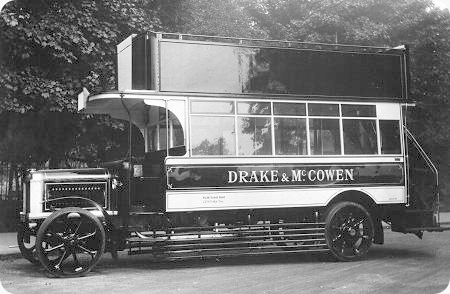Drake & Mc Cowen – Leyland LB2 – XP 435 – B21
Drake & Mc.Cowen
1923
Leyland LB2
Dodson O48RO
I thought I’d lost this photo until I found it today tucked inside a book.
My father was very friendly with Joe Mc.Cowen and I think he fought with his nephew(?) in the war (sadly he was killed in N Africa in 1941).
Joe lived at 1 Bonny Street Camden Town NW1 and I used to go there with my father on a spurious excuse, which I suspect was just a ruse so some heavy drinking could be done. Joe’s place was in terrible condition and stank of old cigars. I think the bus was used on the 3 or 53 route, at least the bus terminus was very close to Bonny St. I remember my father telling me that Drake had run off with the conductress, so I don’t know what happened to the company after that! The picture looks like it might have been taken in Regent’s Park.
I look forward to any comments regarding the above operator or vehicle.
Photograph and Copy contributed by Paul Canty
———
01/07/12 – 09:55
The definitive work on this subject is “London’s Buses Volume 1 – The Independent Era 1922-1934” by Messrs Blacker, Lunn, and Westgate, published by H J Publications in 1977 (and of course long out of print), from which the following information is extracted.
According to the book, the business commenced in August 1923 and was originally a partnership of William Drake of 245 Great College Street N1 and Robert McCowen; but Mr McCowan left the business in about 1926 and Mr Drake continued as sole proprietor until he sold the business to Birch Brothers in October 1928.
Two buses were operated:
XP 435 Leyland LB2 Dodson O26/22RO new 8/23
XT 4603 Leyland LB4 Dodson O26/22RO new 5/24
In addition a second-hand Leyland LB4 Dodson, XP 4355, was acquired for spares in 11/23. Its chassis was dismantled and the body used as a shed.
XT 4603 achieved fame when it was overturned by protestors during the General Strike, but ran in service the next day with its windows boarded over.
The original livery was creamy-yellow and black (or possibly very dark navy) with DRAKE & McCOWAN fleetname in large gold letters as per your photograph. After Mr McCowan left the fleetname was changed to DRAKE. In 1928 the livery was changed to red and white and the fleetname became W. R. Drake in script lettering.
Drake and McCowan are known to have operated on route 27 (their version becoming 206 under the Bassom system in December 1924). Under the 1924 Act one of their buses operated on the 206 and the other on the 284A (unfortunately I have no idea where those routes went in those days).
Drake & McCowan’s buses were originally kept, with those of several other independents, at Dangerfield’s garages in Camden Town and Chalk Farm, but when Dangerfield sold out to the LGOC in 1927 they were moved to Bridge Wharf Garage in Kentish Town Road.
Michael Wadman
———
05/07/12 – 16:20
I know the shiny paintwork and stylish fleet name helps, but what a handsome, well-proportioned bus!
There are good- and not so good-looking vehicles of all periods, but the team that designed this one can look down and be proud.
Ian Thompson
———
05/07/12 – 16:21
Pauls photograph is a great reminder of the era of the London "Pirates". This Dodson body was the most popular fitment to Leyland LB series, and Dennis buses over the whole "Pirate" scene, followed by the Birch body, and, less common, Strachan and Brown.
There is something uniquely distinctive about Dodson bodywork, as has been discussed before, but this is emphasised more when seen on some provincial fleets, notably Wolverhampton, and the style was quite popular in several fleets. Peterborough and District comes to mind, as well as Hastings Tramways.
I wonder if this particular bus was one of the survivors into LT days, which were converted to trolleybus tower wagons.
Thanks for a nice photograph.
John Whitaker
———
05/07/12 – 17:44
If memory serves me right, John W, LPTB stayed true to its AEC roots and used withdrawn NS buses as tower wagons, wire lubricators and, more generally, as tree loppers and mobile canteens. Surprisingly, at a time when many of the first-generation Green Line T’s were being replaced and available for conversion, it also bought some AEC Mercury lorries for use as tower wagons. I have no idea what vehicles LUT used for their ‘Diddler’ system which started in 1931, but maybe continued with the same ones they’d used to maintain the erstwhile tram system. It was all done on the cheap.
Chris Hebbron
———
06/07/12 – 14:14
I refer you to Capital Transport`s "The London Trolleybus Vol.2" re LB Leyland tower wagons. Full details are in there!
The original ADC vehicles were used in LUT days.
John Whitaker
Quick links to the - Comments Page - Contact Page - Home Page
Comments - Please note: The comments facility is not currently available. Please see the home page for updates.
Please Note if you want to send a photograph with your comment please use the Contact Page by clicking here or send as an attachment via email.

